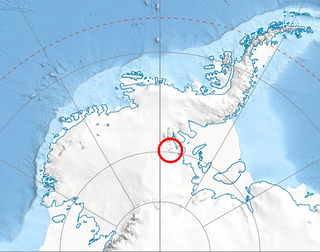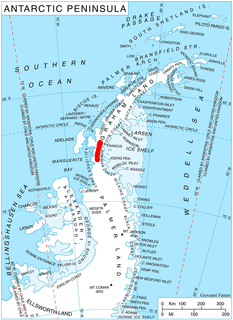
The Wisconsin Range is a major mountain range of the Horlick Mountains in Antarctica, comprising the Wisconsin Plateau and numerous glaciers, ridges and peaks bounded by the Reedy Glacier, Shimizu Ice Stream, Horlick Ice Stream and the interior ice plateau.
The Humboldt Mountains are a group of mountains immediately west of the Petermann Ranges, forming the westernmost portion of the Wohlthat Mountains in Queen Maud Land, Antarctica.

Explorers Range is a large mountain range in the Bowers Mountains of Victoria Land, Antarctica, extending from Mount Bruce in the north to Carryer Glacier and McLin Glacier in the south. Named by the New Zealand Antarctic Place-Names Committee (NZ-APC) for the northern party of New Zealand Geological Survey Antarctic Expedition (NZGSAE), 1963–64, whose members carried out a topographical and geological survey of the area. The names of several party members are assigned to features in and about this range. All of the geographical features listed below lie situated on the Pennell Coast, a portion of Antarctica lying between Cape Williams and Cape Adare.

Astapenko Glacier is a glacier, 11 miles (18 km) long, draining the north and northeast slopes of Stanwix Peak in the Bowers Mountains and flowing east-northeast to Ob' Bay, situated in Victoria Land, Antarctica. It was mapped by the United States Geological Survey from surveys and from U.S. Navy air photos, 1960–62, and named by the Advisory Committee on Antarctic Names for Pavel D. Astapenko, Soviet IGY observer, a Weather Central meteorologist at Little America V in 1958. The glacier lies on the Pennell Coast, a portion of Antarctica lying between Cape Williams and Cape Adare.
The Land Glacier is a broad, heavily crevassed glacier, about 35 nautical miles (60 km) long, descending into Land Bay in Marie Byrd Land, Antarctica. It was discovered by the U.S. Antarctic Service (1939–41) and named for Rear Admiral Emory S. Land, Chairman of the U.S. Maritime Commission.
Mount Brocoum is the dominant peak on the eastern ridge of the Columbia Mountains in Palmer Land. It was mapped by the United States Geological Survey in 1974, and named by the Advisory Committee on Antarctic Names for Stephan J. Brocoum and his wife, Alice V. Brocoum, Columbia University geologists who studied the structure of the Scotia Ridge area. He worked in 1968–69 and 1970–71; she, only the latter season.
Krieger Peak is a peak between Duffy Peak and The Obelisk in the central part of the Staccato Peaks, southern Alexander Island, Antarctica. The peak was photographed from the air by Lincoln Ellsworth in 1935, and was named by the Advisory Committee on Antarctic Names for Lieutenant Commander Charles J. Krieger, U.S. Navy, an aircraft commander in Squadron VXE-6, Operation Deep Freeze, 1969 and 1970.
Fry Peak is a sharp-pointed peak which is the southernmost peak in the Welch Mountains, in Palmer Land, Antarctica. It was mapped by the United States Geological Survey in 1974, and was named by the Advisory Committee on Antarctic Names for Lieutenant Frederick M. Fry, U.S. Navy, a Flight Surgeon and member of the para-rescue team of U.S. Navy Squadron VXE-6 during Operation Deep Freeze 1969 and 1970.
The Gutenko Mountains are a large, scattered group of hills, nunataks and small mountains at the south end of Dyer Plateau in central Palmer Land, Antarctica. The feature includes the Elliott Hills, the Rathbone Hills, the Guthridge Nunataks and the Blanchard Nunataks. These mountains were seen from the air during flights of November 21 and December 23, 1947, by the Ronne Antarctic Research Expedition and are named for Sigmund Gutenko, U.S. Navy, chief commissary steward with the expedition. The mountains were mapped in detail by the United States Geological Survey in 1974.
The Eidshaugane Peaks are a group of peaks 1 nautical mile (2 km) north of Eidsgavlen Cliff in the Humboldt Mountains of Queen Maud Land. They were discovered and photographed by the Third German Antarctic Expedition, 1938–39. They were mapped from air photos and surveys by the Sixth Norwegian Antarctic Expedition, 1956–60, and named Eidshaugane.
Maling Peak is a mountain 430 metres (1,400 ft) high and is the southernmost of two conspicuous peaks 0.5 nautical miles (1 km) northwest of Cape Vik on the south coast of Coronation Island in the South Orkney Islands, Antarctica. It was roughly surveyed in 1933 by Discovery Investigations personnel and was named by the UK Antarctic Place-Names Committee for Derek H. Maling, a Falkland Islands Dependencies Survey meteorologist at Signy Island in 1948 and 1949, who made a survey triangulation of Signy Island and the south coast of Coronation Island.
Manna Glacier is a broad depression-glacier located north of Stevenson Bluff and Mount Steele in the Wilson Hills of Antarctica. It drains northeastward into the eastern part of the Gillett Ice Shelf. The glacier was so named by the northern party of the New Zealand Geological Survey Antarctic Expedition, 1963–64, because of an airdrop of extra comforts from an aircraft which carried the Governor-General of New Zealand over this area was like "manna from heaven".

Schanz Glacier is a glacier 8 nautical miles long in the Heritage Range, draining south between Soholt Peaks and Collier Hills to enter Union Glacier. It was mapped by United States Geological Survey (USGS) from surveys and U.S. Navy air photos in 1961 to 1966. It was named by Advisory Committee on Antarctic Names (US-ACAN) for Lieutenant Commander Thomas L. Schanz, supply officer with U.S. Navy Squadron VX-6 during Deep Freeze in 1965.
Holmes Summit is a peak rising to 1,875 metres (6,150 ft), the highest elevation in the Read Mountains of the Shackleton Range in Antarctica. It was photographed from the air by the U.S. Navy in 1967 and was surveyed by the British Antarctic Survey in the period 1968–71. In association with the names of geologists grouped in this area, it was named by the UK Antarctic Place-Names Committee in 1971 after Professor Arthur Holmes, after whom the Holmes Hills in Palmer Land were also named.
The Kershaw Ice Rumples are a large area of disturbed ice between Fletcher Ice Rise and Korff Ice Rise, in the southwestern part of the Ronne Ice Shelf, Antarctica. The feature appears in U.S. Navy aerial photographs taken in the 1960s and in imagery obtained by the NASA Earth Resources Technology Satellite (ERTS-1), 1973–74. It was named by the UK Antarctic Place-Names Committee for John E.G. Kershaw, a senior pilot with the British Antarctic Survey, 1974–75.

Lewis Glacier is the northerly of two glaciers flowing from Hemimont Plateau east into Seligman Inlet, on the east coast of Graham Land, Antarctica. The glacier was photographed from the air by the United States Antarctic Service in 1940. It was charted in 1947 by the Falkland Islands Dependencies Survey, who named it for British glaciologist William Vaughan Lewis, a lecturer at the Department of Geography, Cambridge University.

Alyabiev Glacier is a glacier in Antarctica, flowing south from Gluck Peak into Boccherini Inlet and lies about 3 miles (5 km) West of Arensky Glacier on Beethoven Peninsula, Alexander Island, It was named by the USSR Academy of Sciences, in 1987, after Alexander Alyabiev (1787-1851), the Russian composer.

Asafiev Glacier is a glacier that flows north-west into Schubert Inlet from the western side of the Walton Mountains, Alexander Island, Antarctica. It was named by the USSR Academy of Sciences in 1987 after Boris Asafiev, the Russian composer.
There are 21 mountain peaks named West Peak in the United States according to the US Geological Survey Geographic Names Information System.






